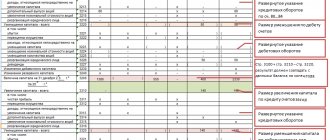The preparation of financial statements is not a type of documentation that can be compiled according to your own templates, but, on the contrary, those documents that are regulated by the Legislation of the Russian Federation and have certain rules for maintaining and drawing up.
In order to prepare high-quality financial statements, it is necessary to comply with the regulations and adhere to the already developed system. Often, accounting specialists often offer more convenient ways to create and maintain reports of this kind. They can be used. The main thing is that you do the work quickly and accurately, and also know what result you plan to get.
What are financial statements
A standard package of financial statements for a commercial organization includes a balance sheet, a statement of financial results, a statement of cash flows and changes in capital. These forms are based on accounting and are needed to analyze information about the organization’s activities and plan further development. They reflect information about the financial position of the company, the profitability or unprofitability of its activities, areas of expenses and sources of income, as well as capital flows.
Additionally, organizations prepare explanations and also submit an audit report along with the reporting if they are subject to a mandatory audit.
What is interim accounting reporting
Accounting statements are summarized information about the financial condition and performance of an organization as of a certain date. The procedure for its provision is regulated by Art. 13 and 14 of the Law of December 6, 2011 No. 402-FZ “On Accounting”.
Any reporting prepared for a period of less than a year is interim (Clause 5, Article 13 of Law No. 402-FZ). However, in practice it is usually calculated for three, six and nine months or monthly.
Only annual reporting is mandatory “by default” for almost all economic entities. But the preparation of interim financial statements is required only in cases where this is expressly indicated:
- in federal laws,
- in the regulations of the Ministry of Finance and other government bodies regulating accounting,
- in constituent documents, decisions of company owners,
- in the contracts concluded by the company.
The frequency, composition, and timing of preparation of interim reporting are fixed in the company's accounting policy.
Types of financial statements
Financial statements can be divided into the following types:
Annual and interim reporting
Interim reporting differs from annual reporting in that it covers a shorter period. It is compiled once a month, quarter or six months. There is no need to submit such reports to the tax office, since most organizations prepare them at their own discretion and for themselves or certain external users.
Interim reporting includes a balance sheet and income statement. Intermediate forms are not approved by law. An organization can take annual reports as a basis and modify them for interim ones.
Full and simplified reporting
Simplified reporting is available to organizations that can conduct accounting according to a simplified scheme. These are small businesses and Skolkovo residents.
The annual simplified reporting must include a balance sheet and a report on financial results. The need for other reporting forms depends on whether they contain information without which it is impossible to objectively assess the financial position and results of the organization’s activities. That is, it is not necessary to include them.
The forms of the balance sheet and financial results report differ from the standard ones. They include indicators only for groups of articles without detail.
Reporting of commercial and non-profit organizations
Commercial and non-profit organizations have different reporting compositions. Thus, commercial organizations usually report on all the forms listed above, but for non-profit organizations there are special features.
Non-profit organizations may not submit any reports to the tax authorities, except for the balance sheet and the report on the intended use of funds, if there is no information for other forms. However, it is recommended to additionally include a report on financial results in the reports in cases where the NPO received significant income from business activities and the data in the target report is not enough to form a reliable picture of the organization’s performance.
Primary and summary consolidated statements
The organization's primary reporting is compiled based on current accounting data. It includes data about one specific organization.
Consolidated reporting is prepared for a group of interrelated organizations. It presents capital, liabilities, income and expenses as total. Consolidated statements show the financial position and financial performance of the entire group rather than each individual organization.
Why is interim reporting needed?
A calendar year is a very long period. During such a time, very serious changes can occur in the company. Naturally, owners want to receive information about their business more often.
In addition to owners, other users may be interested in receiving interim reporting:
- Banks. When applying for a loan, the company usually provides its statements for analysis. Further, in the process of debt servicing, banks also regularly request the borrower’s accounting reports, including interim reporting.
- Counterparties. When working on large and long-term contracts, the company’s partners usually also want to regularly receive information about the status of their counterparty.
Rules for preparing financial statements
The reporting rules are approved in PBU 4/99. Of the basic requirements:
- Russian language;
- currency of the Russian Federation;
- data in thousands of rubles without decimal places;
- no erasures or blots;
- indicators with a negative value are indicated in brackets;
- missing indicators are replaced with a dash;
- the balance sheet includes indicators in net valuation, that is, minus regulatory values;
- reporting data for the reporting period must be comparable with reporting data for previous periods.
For each numerical reporting indicator, except for the report for the first year, data must be provided for at least two years - the reporting year and the previous one.
The reporting is considered completed after it is signed by the manager, chief accountant or other official responsible for signing it.
The annual reporting must be approved at the general meeting of participants (shareholders). The deadline for holding the meeting is determined in the charter. It must fall within the period:
- for LLC - from March 1 to April 30;
- for JSC - from March 1 to June 30.
The decision to approve the reporting is documented in the minutes of the general meeting. It must indicate the number, date, location, agenda, information about participants and voting results.
If the LLC has one participant, his decision, drawn up in any order, is sufficient to approve the reporting.
Since the period for approval of reporting is longer than the period for its preparation. You can also submit unapproved reports to the Federal Tax Service.
Going to court
The essence of the claim: invalidation of paragraph 48 of PBU 4/99 and paragraph 29 of the Regulations on Accounting and Financial Reporting in the Russian Federation due to their contradiction to parts 2, 4 of Article 13 of Federal Law No. 402-FZ “On Accounting”.
The claim is motivated by the fact that, within the meaning of Part 4 of Article 13 No. 402-FZ, the preparation of interim financial statements by organizations is an exception to the general rule (preparation of annual statements) and is applied only in certain cases.
At the same time, this norm limits the circle of persons and the type of regulations and local acts that may introduce the obligation to maintain such reports. And paragraph 48 of PBU 4/99 and paragraph 29 of the Regulations on accounting and financial reporting in the Russian Federation establish the obligation to maintain interim reporting for all organizations without indicating specific cases and situations in which this rule applies. It should be noted that these paragraphs are much broader in content than Part 4 of Article 13 No. 402-FZ.
These regulations cannot be considered as a special case of application of Part 4 of Article No. 402-FZ, since with such an erroneous (broad) interpretation, all organizations, without exception, must prepare interim reports. And this completely deprives the legal norm of meaning.
According to the administrative plaintiff, the contested regulations create uncertainty for adoption and run counter to the rights and interests of the organization. Because the actual value of the share that the company is obliged to pay to the participant who left the company depends on the decoding of the concept of “reporting period”.
Reporting procedure
The procedure for submitting annual financial statements and the auditor’s report was approved by Order of the Federal Tax Service of Russia dated November 13, 2019 No. ММВ-7-1/ [email protected]
Organizations must submit reports to the tax office at their location. The deadline for this is 3 months after the end of the reporting period. In 2021, the reporting deadline is March 31.
There is no need to submit reports for 2021 to the statistical authorities. This obligation remains only for organizations whose reports contain state secret information, as well as in cases established by the Government of the Russian Federation.
The reporting form is exclusively electronic. As of 2020, all organizations cannot submit forms on paper.
Who submits interim financial statements according to the law?
The above cases of provision of interim reports are due to “local” regulations related to specific enterprises. But there are also general norms of law that oblige certain categories of economic entities to prepare interim reporting, like this:
- Insurers provide financial statements to the insurance supervisory body (including intermediate ones) in the manner established by this body (clause 4 of article 28 of the law of November 27, 1992 No. 4015-1 “On the organization of insurance business in the Russian Federation”).
- Issuers of securities provide disclosure of information, which includes quarterly financial statements (clauses 6, 7, Article 30 of Law No. 39-FZ of April 22, 1996 “On the Securities Market”).
Financial reporting forms
Accounting statements are prepared and presented in accordance with the forms approved by Order of the Ministry of Finance of Russia dated July 2, 2010 No. 66n. Let's consider the content and procedure for filling out the main forms of the annual financial statements of a commercial organization.
Balance sheet
The balance sheet form is approved by Appendix No. 1 to Order of the Ministry of Finance of the Russian Federation dated July 2, 2010 No. 66n. It characterizes the financial position of the enterprise.
The balance sheet is divided into two sections - assets and liabilities. The main principle of balance is that equality must be maintained between them.
Assets, in turn, are divided into current and non-current. Current assets include inventories, VAT, accounts receivable, financial investments and cash. Non-current - intangible assets, fixed assets, property for leasing or rental, etc.
Liabilities include three sections: capital and two types of liabilities - less than and more than 12 months. The capital section also includes retained earnings or uncovered losses.
Income statement
It describes the organization's performance for the year. Shows the reasons why the profit or loss occurred. The data in the report is shown for the past and previous year.
Revenue in the report is shown net of VAT, excise taxes and other mandatory payments. By reducing it by the cost of sales, you can get a gross profit. It shows the profit (loss) from sales after reduction by selling and administrative expenses. To identify net profit (loss), interest, other income and expenses, income tax, changes in IT and IT are additionally taken into account.
The net profit indicator should be equal to the final balance in account 99 “Profits and losses”, which, when reforming the balance sheet, is written off to account 84 “Retained earnings (uncovered loss)”.
Statement of changes in equity
Capital is the investments of the owners and the profit accumulated over the entire period of operation of the enterprise. The statement of changes in equity consists of three sections: capital movements, adjustments, and net assets.
The first section contains information about changes in equity capital. It includes authorized, additional and reserve capital, as well as retained earnings.
The second section is filled out if in the reporting year the organization corrected errors of previous years using account 84 or if the accounting policy changed in the reporting year. Amounts for past years need to be adjusted in order to compare the amount of capital of the previous and the year before with the reporting year.
The third section provides information on net assets for three years - December 31 of the reporting year and the two previous ones.
Cash flow statement
This report is a summary of the company's cash and cash equivalents. It reveals data on what amounts the company had at the beginning of the year and how much was left at the end. The report characterizes three types of cash flow: in the context of current, investment and financial activities.
At its core, the cash flow statement is an explanation of line 1250 of the balance sheet. It should indicate its presence.
Explanations for the balance sheet and financial results report
Explanations disclose information that relates to the accounting policies of the organization. They also contain additional information that is not included in the balance sheet and report, but is needed by users of financial statements to understand the processes and state of the organization.
Explanations reveal additional information:
- about intangible assets;
- fixed assets;
- financial investments;
- accounts receivable;
- changes in capital;
- shares issued by a joint stock company;
- reserves for future expenses and payments, estimated reserves;
- accounts payable;
- sales volumes of products, goods, works, services by type of activity and sales markets;
- production costs;
- and other components of the organization’s activities.
This information is presented in the form of separate reporting forms and in the form of an explanatory note. The reporting article to which explanations are given must indicate their presence.
Reporting tools
To make working with reporting easier, many special services and programs have been created. They automate calculations, help optimize tasks and spend less time on reporting.
The most basic tool is an accounting program. Nowadays there are few companies left that keep records and generate reports manually. Large enterprises have long switched to special programs that allow several accountants to work together and perform all their tasks: keep records of primary documents, consolidate data by department, generate reports, prepare analytics based on any parameters, and much more. Such programs include Kontur.Accounting Asset.
Small businesses often choose online services that help them perform basic accounting operations and submit reports: Kontur.Accounting or Kontur.Elba.
Another indispensable tool is the Microsoft Office software package. For example, Excel is often used by financial directors and economists to generate internal analytics, non-standard calculations, and compilation of special tables. All this helps management make the right management decisions.
You can now submit financial statements only in electronic format. To do this, you can use the electronic service of the Federal Tax Service or connect a special system for online reporting - Kontur.Extern.








